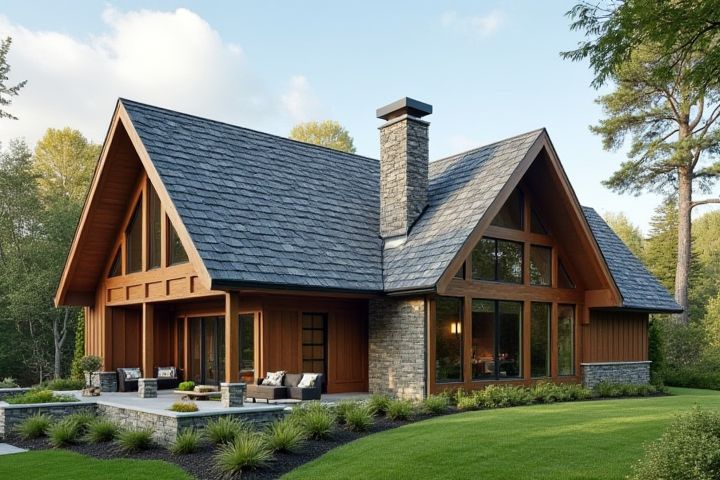
House roof shapes significantly impact both aesthetics and functionality. For instance, gable roofs enhance ventilation and provide a classic look, while flat roofs offer modern design and additional outdoor space. The slope of a roof affects rainwater drainage; steeper roofs prevent water accumulation, reducing maintenance issues. In regions prone to heavy snowfall, hipped roofs are advantageous due to their ability to evenly distribute weight, minimizing the risk of collapse. Your choice of roof shape can also influence energy efficiency, with certain designs optimizing solar energy capture for sustainable living.
Why House Roof Shapes Matter
Drainage efficiency
The shape of your house roof plays a critical role in drainage efficiency, significantly impacting water runoff and potential water damage. Sloped roofs, for example, encourage rainwater to flow towards gutters, reducing the risk of stagnant water that can lead to leaks or structural decay. Flat roofs, while easier to construct, require more diligent maintenance to ensure proper drainage systems are in place, as accumulated water can lead to pooling and increased weight. By selecting the right roof shape, homeowners can enhance the longevity of their roof and safeguard against expensive repairs related to drainage issues.
Wind resistance
The shape of a house roof significantly influences wind resistance, as aerodynamic designs can reduce wind load on structures. For example, a gabled roof, with its sloped surfaces, allows wind to flow more smoothly, minimizing uplift and potential damage. Conversely, flat roofs often struggle against strong winds, leading to increased pressure and potential structural failures. Choosing the right roof shape can enhance your home's durability, especially in high-wind regions, where the risk of wind-related damage is considerable.
Aesthetic appeal
The shape of a house roof significantly influences its aesthetic appeal, contributing to the overall architectural style and character of the home. A sloped roof, for instance, can evoke a traditional or rustic charm, while a flat roof often embodies a modern and minimalist aesthetic. The symmetry of a gabled roof can enhance visual balance, creating an inviting atmosphere, whereas the unique lines of a hipped roof can add a dynamic flair to the exterior. Choosing a roof shape that complements the home's design not only boosts curb appeal but also enhances your property's market value.
Energy efficiency
House roof shapes significantly impact energy efficiency by influencing thermal performance and natural light management. A steeply pitched roof allows for better ventilation, reducing heat buildup in warmer climates, while a flat roof can facilitate the installation of solar panels, enhancing energy generation. Roof overhangs play a crucial role in minimizing solar heat gain during the summer months, effectively keeping your home cooler and reducing reliance on air conditioning. Understanding your roof shape can enhance insulation strategies, ultimately lowering energy bills and creating a more sustainable living environment.
Snow load management
House roof shapes play a crucial role in managing snow load, influencing structural integrity and safety during winter months. Steeply pitched roofs facilitate snow shedding, reducing accumulation and the risk of roof collapse under heavy snow weight. In contrast, flat or low-slope roofs may collect snow, necessitating regular maintenance to prevent potential damage or structural failure. Choosing the appropriate roof design based on regional snowfall patterns can enhance your home's longevity and ensure a safer living environment.
Material suitability
House roof shapes significantly influence material suitability, impacting durability and insulation. For instance, gabled roofs often allow for better ventilation, making them compatible with lighter materials like asphalt shingles. In contrast, flat roofs require materials such as rubber or modified bitumen that can withstand water pooling while maintaining structural integrity. Selecting the right roof shape in conjunction with appropriate materials ensures optimal performance and longevity of your home's protection against weather elements.
Local climate adaptation
House roof shapes are crucial for local climate adaptation, as they directly impact water runoff, thermal efficiency, and energy consumption. For instance, sloped roofs facilitate effective rainwater drainage in regions prone to heavy rainfall, reducing the risk of leaks and structural damage. Conversely, flat roofs can be advantageous in arid climates, allowing for the installation of solar panels and rooftop gardens that aid in insulation and cooling. By selecting the appropriate roof shape, you can enhance your home's resilience to extreme weather conditions while optimizing energy use and maintaining comfort.
Historical and cultural influences
House roof shapes reflect historical and cultural influences, highlighting regional adaptations to climate and societal needs. For instance, steep gabled roofs in Northern Europe are designed to prevent snow accumulation, while flat roofs are prevalent in arid regions, providing additional living space. In East Asia, the sweeping curves of pagoda roofs symbolize harmony with nature and reinforce spiritual beliefs. Understanding these architectural choices allows You to appreciate the interplay between environment, tradition, and identity in residential design.
Cost implications
House roof shapes significantly impact construction costs, as complex designs often require more materials and labor. Gable roofs, for example, are generally more economical, utilizing fewer materials and allowing for quicker installation compared to intricate shapes like hipped or mansard roofs. The slope of your roof can also influence long-term expenses, with steeper roofs providing better drainage but potentially increasing initial costs due to specialized labor. By considering these factors, you can optimize your budget while ensuring that your roof meets functional and aesthetic needs.
Functional versatility
House roof shapes significantly influence functional versatility, impacting everything from aesthetic appeal to practical efficiency. Gable roofs, for instance, allow for effective water drainage while providing ample attic space for storage or living areas. In contrast, flat roofs offer modern design flexibility and are ideal for rooftop gardens or solar panel installations. Your choice of roof shape can enhance energy efficiency, accommodate local climate conditions, and influence maintenance requirements, ultimately shaping your home's usability and comfort.
